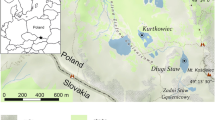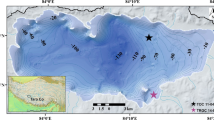Abstract
Sediment cores from two neighbouring lakes (Viitna Linajärv and Viitna Pikkjärv) in northern Estonia were studied to determine lake-level fluctuations during the Holocene and their impact on biogeochemical cycling. Organic matter and pollen records dated by radiocarbon and radiolead indicated a water level rise in both lakes during the early Holocene (c. 10 000–8000 BP). A regression followed around 7500 BP and several transgressions occurred during the latter half of the Holocene, c. 6500 and 3000 BP. Human impact during the last centuries has caused short-term lake-level fluctuations and accelerated sediment accumulation in the lakes. The differences in water depth led to variations in sediment formation. During 10 000–8000 BP (Preboreal and Boreal chronozones) mineral-rich sediments with coloured interlayers deposited in L. Linajärv. These sediments indicate intensive erosion from the catchment and oxygen-rich lake, which favoured precipitation of iron oxides and carbonates. Fluctuations in water depth, leaching of nutrients from catchment soils and climatic changes increased the trophy of L. Linajärv around 6000 BP. The subsequent accumulation of gyttja, the absence of CaCO3 and the decrease in both the C/N ratio and phosphorus content in the sediments also indicate anoxic conditions in the hypolimnion. The similarity in the development of L. Linajärv and L. Pikkjärv and their proximity made it possible to discern the impact of water depths changes on biogeochemical cycling in lakes.
Similar content being viewed by others
References
Appleby P.G., Richardson N. and Nolan P.J. 1992. Self-absorbtion corrections for well-type germanium detectors. Nucl. Instr. and Methods 71: 228-233.
Bengtsson L. and Enell M. 1986. Chemical analysis. In: Berglund B.E. (ed.), Handbook of Holocene Palaeoecology and Palaeohydrology. John Wiley and Sons, Chichester-New York, pp. 423-451.
Chambers F.M. (ed.) 1993. Climate Change and Human Impact on the Landscape. Chapman and Hall, 303 pp.
Cuddinngton K. and Leavitt PR. 1999. An individual-based model to pigment flux in lakes: implications for organic biogeochemistry and paleoecology. Can. J. Fish. Aquat. Sci. 56: 1964-1977.
Dean W.E. 1999. The carbon cycle and biogeochemical dynamics in lake sediments. J. Paleolim. 21: 375-393.
Digerfeldt G. 1986. Studies on past lake-level fluctuations. In: Berglund B.E. (ed.), Handbook of Holocene Palaeoecology and Palaeohydrology. JohnWiley and Sons, Chichester-New York, pp. 127-143.
Digerfeldt G. and Hakansson H. 1993. The Holocene paleolimnology of Lake Sämbosjon. Southwestern Sweden. J. Paleolim. 8: 189-210.
Engstrom D.R., Swain E.B. and Kingston J.C. 1985. A paleolimnological record of human disturbance from Harvey's Lake, Vermont: geochemistry, pigments and diatoms. Freshw. Biol. 15: 261-288.
Harrison S.P. and Digerfeldt G. 1993. European lakes as palaeohydrological and palaeoclimatic indicators. Quat. Sci. Rev. 12: 233-248.
Hassan K.M., Swinehart J.B. and Spalding R.F. 1997. Evidence for Holocene environmental change from C/N ratio, and δ13C and δ5N values in Swan Lake sediments, western Sand Hills, Nebraska. J. Paleolim. 18: 121-130.
Hieltjes A.H.M. and Lijklema L. 1980. Fractionation of inorganic phosphates in calcareous sediments. J. Environ. Qual. 9: 405-407.
Laasimer L. 1965. Eesti NSV tairnkate. Tallinn, Valgus, 397 pp. [Vegetation of the Estonian SSR. In Estonian with English summary].
Lami A., Marchetto A., Lobianco R., Appleby P.G. and Guilizzoni P. 2000. The last ca 2000 years palaeolimnology of Lake Gandia (N. Italy): inorganic geochemistry, fossil pigments and temperature time-series analyses. J. Limnol. 59: 31-46.
Leavitt PR. 1993. A review offactors that regulate carotenoid and chlorophyll deposition and fossil pigment abundance. J. Paleolim. 9: 109-127.
Moore P. and Webb J.A. 1978. An Illustrated Guide to Pollen Analysis. Hodder and Stoughton, London, Sydney, 133 pp.
Noe-Nygaard N. and Heiberg E.O. 2001. Lake-level changes in the Late Weichselian Lake Tovelde, Mon, Denmark: induced by changes in climate and base level. Palaeogeogr., Palaeoclim., Palaeoecol. 174: 351-382.
Paal J. 1997. Classification of Estonian Vegetation Site Types. Tallinn, Ministry of Environment and UNEP, 297 pp.
Poska A. and Saarse L. 1999. Holocene vegetation and land-use history in the environs of Lake Kahala, northern Estonia. Veget. Hist. Archaeobot. 8: 185-197.
Punning J.-M. and Koff T. 1996. Does the climate in the future have analogues in the past? In: Punning J.-M. (ed.), Estonia in the System of Global Climate Change Vol. 4. Inst. of Ecology, Tallinn, Publ., pp. 75-83.
Punning J.-M. and Tõ ugu K. 2000. C/N ratio and fossil pigments in sediments of some Estonian lakes: an evidence of human impact and Holocene environmental change. Environ. Monit. and Assessm. 64: 549-567.
Punning J.-M., Ilomets M., Koff T., Paap Ñ and Rajamäe R. 1987. On the development of Lake Ñmarjarv (NE Estonia) in the Holocene. In: Raukas A. and Saarse L. (eds), Palaeoecology of the temperate zone. II. Lakes. Tallinn, pp. 123-136.
Saarse L. 1992. Viitna mõ hnastiku ja järvede kujunemisest. Eesti Geograafia Seltsi Aastaraamat 27. Valgus, Tallinn, [On the development of Viitna Kame Field and lakes. Year-book of the Estonian Geographical Society 27. In Estonian with English Summary], pp. 30-43.
Saarse L. and Harrison S.P. 1992. Holocene lake-level changes in the Eastern Baltic region. In: Kaare T., Mardiste H., Merikaiju L. and Punning J.-M. (eds), Estonia: Man and Nature. Tallinn, pp. 6-20.
Saarse L., Poska A., Kaup E. and Heinsalu A. 1998. Holocene environmental events in the Viitna area, North Estonia. Proc. Estonian Acad. Sci. Geol. 47: 31-44.
Shapiro J., Edmonson W.T. and Allison D.E. 1971. Changes in the chemical composition of sediments of Lake Washington, 1958-1970. Limnol. Oceanogr. 16: 437-452.
Street-Perrot F.A. and Harrison S.P. 1985. Lake levels and climate reconstructions. In: Hecht A.D. (ed.), Paleoclimate Analysis and Modeling. John Wiley and Sons, New-York, pp. 291-340.
Swain E.B. 1985. Measurement and interpretation of sedimentary pigments. Freshwater Biol. 15: 53-75.
Wetzel R.G. 1983. Limnology. Saunders College Publishing, Fort Worth, Philadelphia, 767 pp.
Author information
Authors and Affiliations
Rights and permissions
About this article
Cite this article
Punning, JM., Kangur, M., Koff, T. et al. Holocene lake-level changes and their reflection in the paleolimnological records of two lakes in northern Estonia. Journal of Paleolimnology 29, 167–178 (2003). https://doi.org/10.1023/A:1023291217456
Issue Date:
DOI: https://doi.org/10.1023/A:1023291217456




